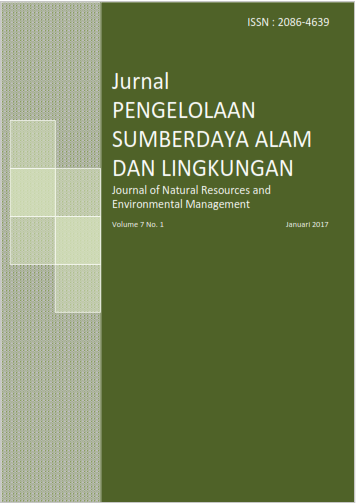ANALISIS TIPOLOGI TUTUPAN VEGETASI SEBAGAI DASAR PENYUSUNAN STRATEGI RESTORASI DI AREA IUPHHK-RE PT REKI
Abstract
References
Bischoff, W., D. M. Newberry, M. Lingenferder, R. Schnaeckel, G. H. Petol, L. Madani, C. E. Risdale, 2005. Secondary Succesion and dipterocarpaceae recruitment in Borneo Rain forest after logging. Forest Ecology Management 218 (2005), pp.174-192.
Burung Indonesia, Royal Societ for Protection of the Birds, Harapan Rainforest Management Unit, 2014. Rencana Pengelolaan Strategi Hutan Harapan 2014-2040. PT REKI, Bogor.
Dendang B., W. Handayani, 2015. Struktur dan komposisi tegakan hutan di Taman Nasional Gunung Gede Pangrango, Jawa Barat. Pros Sem Nas Masy Biodiv Indon. 4 (1), pp.691-695.
[FWI] Forest Watch Indonesia, 2011. Potret Keadaan Hutan Indonesia Periode 2009-2013. Forest Watch Indonesia, Bogor.
Ghazoul, J., D. Sheil, 2009. Tropical Rain Forest Ecology, Diversity, and Conservation. Oxford University Press, New York.
Heriansyah, I., I. Miyakuni, T. Kato, Y. Kiyono, Y. Kanazawa, 2007. Growth characteristics and biomass of Acacia mangium under different management practices in Indonesia. Journal of Tropical Forest Science 19 (4), pp 226-235.
Htun, N.Z., N. Mizoue, S. Yoshida, 2011. Tree species composition and diversity at different levels of disturbance in Popa Mountain Park, Myanmar. Biotropica 43 (5), pp. 597–603.
Indriyanto, 2008. Ekologi Hutan. PT Bumi Aksara, Jakarta.
Indriyanto, 2006. Pengantar Budidaya Hutan. PT Bumi Aksara, Jakarta.
Katrodiharjo, H., Bismak, I. Heriansyah, M. Silalahi, A.U. Budi, K. Zaini, Asmul, A. Ayat, Andriansyah, S. Sitorus, Y. Cahyadin, 2014. Naskah Akademik Rancangan Peraturam Pengelolaan Izin Usaha Pemanfaatan Hasil Hutan Kayu Restorasi Ekosistem. PT REKI, Jambi.
[KLHK] Kementrian Lingkungan Hidup dan Kehutanan, 2015. Statistik Kementrian Lingkungan Hidup dan Kehutanan 2014. KLHK, Jakarta.
Ludwig, A.J, F.J. Reynolds, 1998. Statistical Ecology. Wiley & Sons Inc, New York.
Mawazin, A. Subiakto, 2013. Keanekaragaman dan komposisi jenis permudaan alam hutan rawa gambut bekas tebangan di Riau. Forest Rehabilitation Journal 1 (1), pp. 59-73.
[Menhut] Menteri Kehutanan. 2014. Peraturan Menteri Kehutanan Nomor: P.64/Menhut-II/2014 tentang Penerapan Silvikultur dalam Area Izin Usaha Pemanfaatan Hasil Hutan Kayu Restorasi Ekosistem pada hutan Produksi. Kementrian Kehutanan, Jakarta.
Misra, C.K, 1980. Manual of Plant Ecology. 2nd ed. Oxford and IBH Publishing Co, New Delhi.
Muhdin, E. Suhendang, D. Wahjono, H. Purnomo, Istomo, dan B. C. H Simangunsong, 2008. Keragaman struktur tegakan hutan alam sekunder. Jurnal Manajemen Hutan Tropika 14 (2), pp. 81-87.
Pamoengkas, P., 2011. Tinjauan silvikultur dan penerapannya dalam pengelolaan hutan alam produksi. Di dalam Sabaruddin, U. Wiharjo, A. Satya, D. Pirnanda. Prosiding Lokakarya Nasional Membangun Strategi Pengelolaan Restorasi Ekosistem di Hutan Produksi; 2011 Okt 11-12; Palembang, Indonesia. PT REKI, Palembang, pp. 24-34.
Siregar, N, 2005. Atlas Benih Tanaman Hutan Indonesia. Jilid V. Balai Penelitian Teknologi Perbenihan, Bogor.
Soerianegara, I., A. Indrawan. 2014. Ekologi Hutan Indonesia. Laboratorium Ekologi Hutan, Fakultas Kehutanan, IPB, Bogor.
Supranto, J, 2009. Statistik: Teori dan Aplikasi Edisi Ketujuh. Erlangga, Jakarta.
Sutomo, 2009. Kondisi vegetasi dan panduan inisiasi restorasi ekosistem hutan di bekas area kebakaran Bukit Pohen Cagar Alam Batukahu Bali (suatu kajian pustaka). Jurnal Biologi 8 (2), pp. 45-50.
Suwardi, A. B., E. Mukhtar, Syamsuardi, 2013. Komposisi jenis dan cadangan karbon di hutan tropis dataran rendah, Ulu Gadut, Sumatera Barat. Berita Biologi 12 (2), pp. 169-176.
Zuur, A.F., E. N. Ieonp, G.M Smith, 2007. Analysing Ecological Data. Springer Science, New York.
Authors
Authors who publish with this journal agree to the following terms:
- Authors retain copyright and grant the journal right of first publication with the work simultaneously licensed under a Creative Commons Attribution License that allows others to share the work with an acknowledgement of the work's authorship and initial publication in this journal.
- Authors are able to enter into separate, additional contractual arrangements for the non-exclusive distribution of the journal's published version of the work (e.g., post it to an institutional repository or publish it in a book), with an acknowledgement of its initial publication in this journal.
- Authors are permitted and encouraged to post their work online (e.g., in institutional repositories or on their website) prior to and during the submission process, as it can lead to productive exchanges, as well as earlier and greater citation of published work (See The Effect of Open Access).






